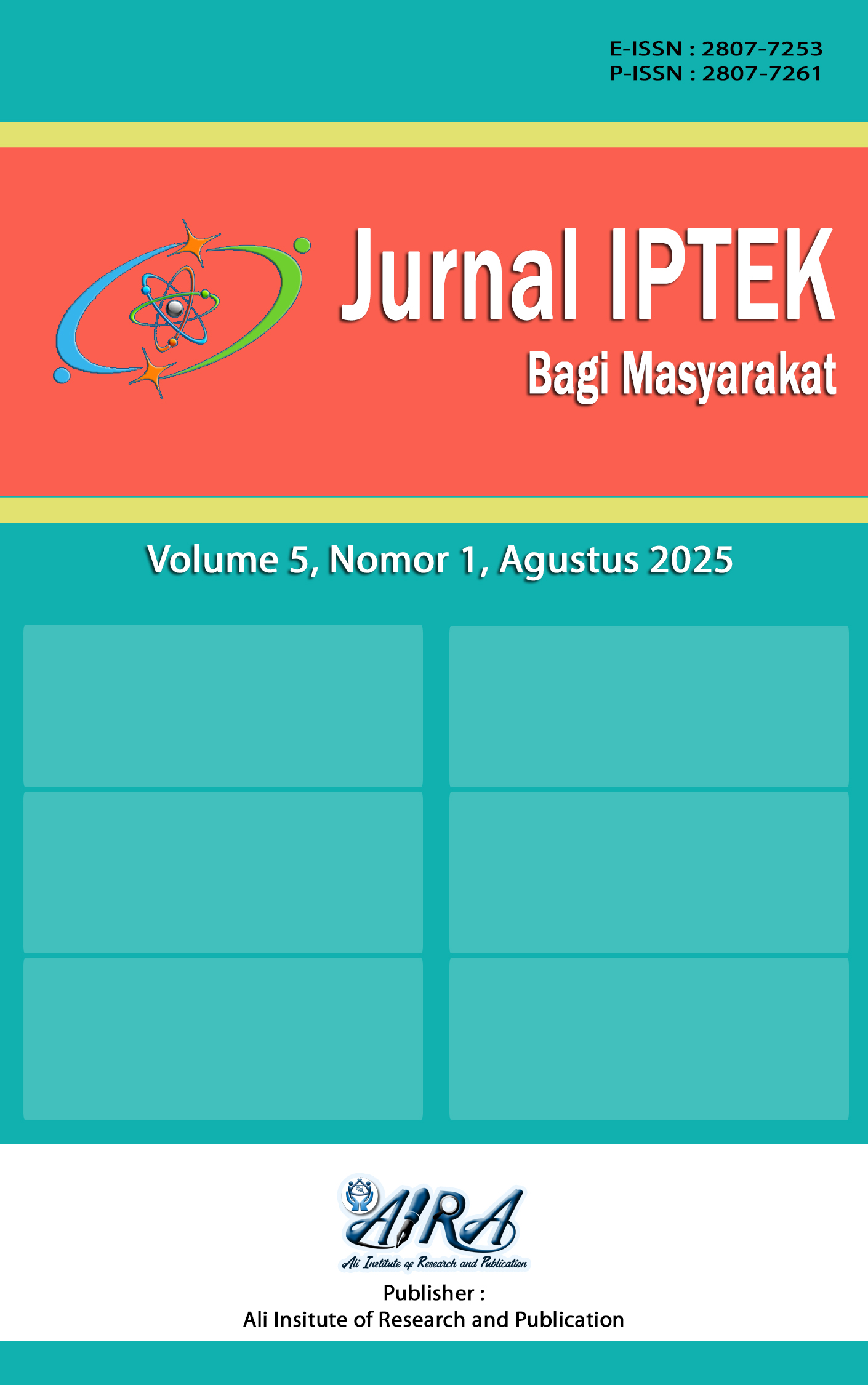Training on Environmental Poster Design Based on Physics Data by Vocational High School Students as Agents of Change
DOI:
https://doi.org/10.55537/j-ibm.v5i1.1287Keywords:
community empowerment, SMK N 1 Portibi, technology training, skills improvement, vocational educationAbstract
Environmental issues such as global warming, air pollution, and climate change require the active participation of all levels of society, including the younger generation. Vocational high school students, as future skilled workers, have great potential to become agents of change through relevant skills in their field. This community service activity aims to enhance the understanding and awareness of students at SMK Negeri 1 Portibi regarding environmental issues through training in environmental poster design based on environmental physics data. The method used is a project-based learning approach, consisting of introducing environmental physics concepts, collecting field data (temperature, humidity, and light intensity), conducting simple analysis, and creating digital posters using graphic design software such as Canva and CorelDraw. The activity was attended by students from various departments, with a participation rate of more than 90% completing the entire training series. The results show a significant improvement in students’ understanding of environmental physics concepts as well as their graphic design skills. The produced posters are not only informative but also communicative and visually appealing, making them effective as environmental campaign media in schools. This activity demonstrates that integrating science and art can be an innovative educational strategy to encourage students’ roles as agents of change in preserving the environment.
Downloads
References
Bateman, S., Mandryk, R. L., Gutwin, C., Genest, A., McDine, D., & Brooks, C. (2010). Useful junk? The effects of visual embellishment on comprehension and memorability of charts. Proceedings of the SIGCHI Conference on Human Factors in Computing Systems, 2573–2582. https://doi.org/10.1145/1753326.1753716
Bringle, R. G., & Hatcher, J. A. (1996). Implementing service learning in higher education. The Journal of Higher Education, 67(2), 221–239. https://doi.org/10.1080/00221546.1996.11780257
Badan Pusat Statistik. (2022). Indeks kualitas lingkungan hidup Indonesia 2022. Jakarta: BPS.
Cronbach, L. J. (1951). Coefficient alpha and the internal structure of tests. Psychometrika, 16(3), 297–334. https://doi.org/10.1007/BF02310555
Dillard, C. (2020). Project-based learning in vocational education: Fostering critical thinking and communication skills. Journal of Vocational Education Research, 45(2), 105–118. https://doi.org/10.5328/JVER45.2.105
Field, A. (2013). Discovering statistics using IBM SPSS statistics (4th ed.). SAGE.
Hake, R. R. (1999). Analyzing change/gain scores. Unpublished manuscript, Indiana University. Retrieved from http://www.physics.indiana.edu/~sdi/AnalyzingChange-Gain.pdf
Joshi, A., Kale, S., Chandel, S., & Pal, D. K. (2015). Likert scale: Explored and explained. British Journal of Applied Science & Technology, 7(4), 396–403. https://doi.org/10.9734/BJAST/2015/14975
Kemmis, S., & McTaggart, R. (2014). The action research planner: Doing critical participatory action research. Springer.
Knowles, M. S. (1975). Self-directed learning: A guide for learners and teachers. Association Press.
Kementerian Pendidikan, Kebudayaan, Riset, dan Teknologi. (2023). Statistik pendidikan kejuruan 2023. Jakarta: Kemendikbudristek.
Kurniawan, A., & Sari, R. (2021). Graphic design learning in vocational schools: Between aesthetics and scientific content. Jurnal Pendidikan Teknologi dan Kejuruan, 27(1), 15–24. https://doi.org/10.21831/jptk.v27i1.12345
Lestari, N., Fadilah, A., & Susanto, H. (2022). Project-based creative learning to enhance data literacy and visual communication skills. Journal of Educational Technology, 18(3), 221–232. https://doi.org/10.24036/et.v18i3.9876
McInerny, G. J., Chen, M., Freeman, R., Gavaghan, D., Meyer, M., Rowland, F., … Hortal, J. (2014). Information visualisation for science and policy: Engaging users and avoiding bias. Trends in Ecology & Evolution, 29(3), 148–157. https://doi.org/10.1016/j.tree.2014.01.003
Mamur, N., Kutlu, Ö., Doğan, S., & Ceylan, E. (2014). Project-based learning in vocational education: A case study. Procedia - Social and Behavioral Sciences, 116, 345–349. https://doi.org/10.1016/j.sbspro.2014.01.220
Mulyani, R., & Santoso, H. (2021). Multimedia-based learning to enhance student motivation and understanding in vocational education. International Journal of Instructional Media, 48(2), 123–134. https://doi.org/10.1080/08923647.2021.1234567
Nugroho, A., & Putra, R. (2023). Integrating STEM and visual communication through project-based learning in vocational education. Jurnal Inovasi Pendidikan Vokasi, 19(2), 201–215. https://doi.org/10.17509/jipv.v19i2.56789
Peterson, R. (2018). Principles of visual communication in educational poster design. Journal of Visual Literacy, 37(1), 1–15. https://doi.org/10.1080/1051144X.2018.1454967
Rahmawati, Y., & Kurniawan, D. (2021). Participatory action training to improve environmental literacy in vocational high schools. Jurnal Pendidikan Sains, 9(2), 85–96. https://doi.org/10.26714/jps.9.2.2021.85-96
Sugiyono. (2019). Metode penelitian kuantitatif, kualitatif, dan R&D. Bandung: Alfabeta.
Suryadi, D., Rahayu, W., & Fitria, A. (2020). Teacher competence in integrating digital media into learning: A case study in vocational schools. Journal of Educational Research and Development, 39(4), 412–425. https://doi.org/10.3102/0034654320942789
Trilling, B., & Fadel, C. (2009). 21st century skills: Learning for life in our times. Jossey-Bass.
World Health Organization. (2023). Climate change and health. Retrieved from https://www.who.int/news-room/fact-sheets/detail/climate-change-and-health
Downloads
Published
How to Cite
Issue
Section
License
Copyright (c) 2025 Hanifah Nur Nasution, Ahmad Zainy, Roy Mirdan Lubis, Thofik Hidayat, Sari Wahyuni Rozi Nasution, Rahmad Fauzi

This work is licensed under a Creative Commons Attribution-NonCommercial-ShareAlike 4.0 International License.




